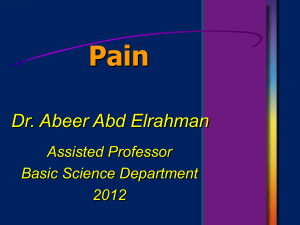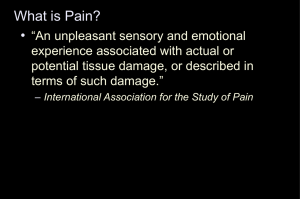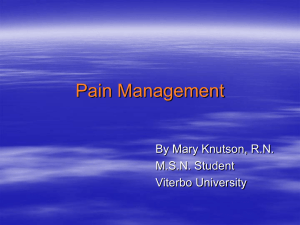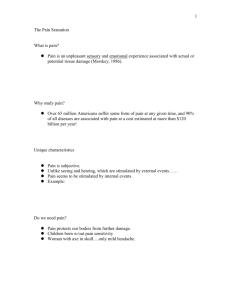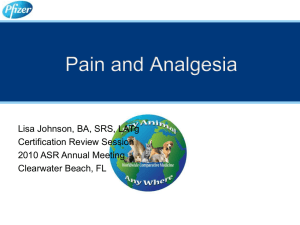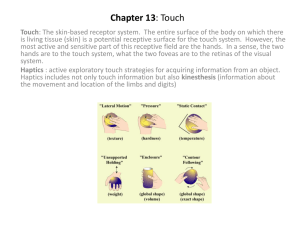Pain
advertisement
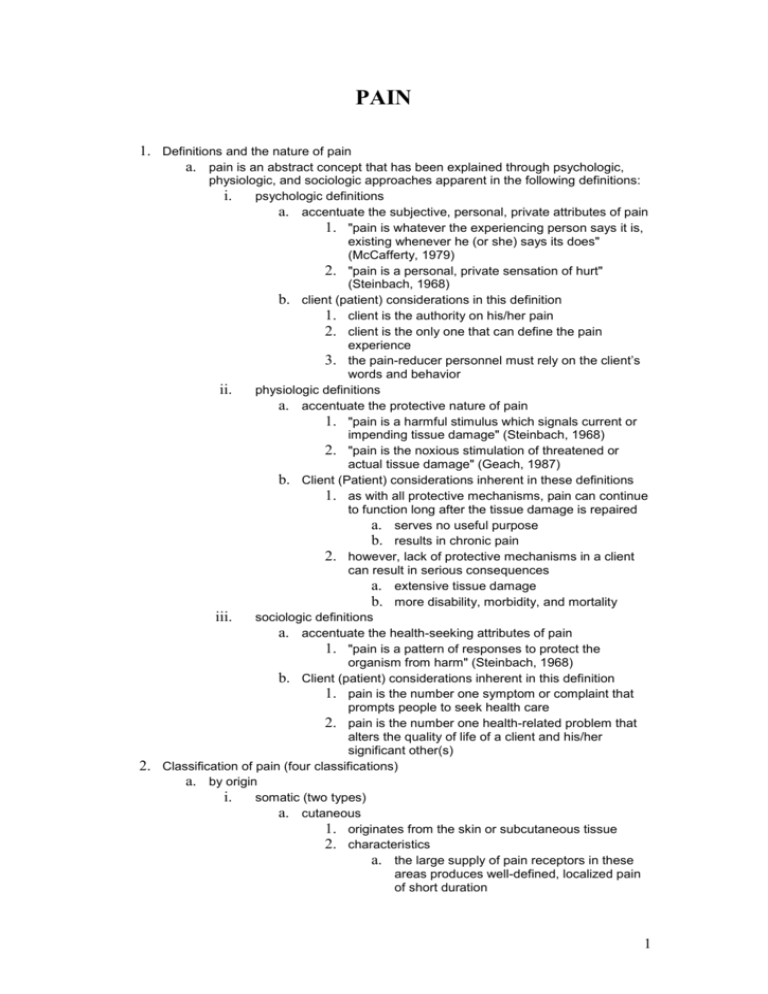
PAIN 1. Definitions and the nature of pain a. pain is an abstract concept that has been explained through psychologic, 2. physiologic, and sociologic approaches apparent in the following definitions: i. psychologic definitions a. accentuate the subjective, personal, private attributes of pain 1. "pain is whatever the experiencing person says it is, existing whenever he (or she) says its does" (McCafferty, 1979) 2. "pain is a personal, private sensation of hurt" (Steinbach, 1968) b. client (patient) considerations in this definition 1. client is the authority on his/her pain 2. client is the only one that can define the pain experience 3. the pain-reducer personnel must rely on the client’s words and behavior ii. physiologic definitions a. accentuate the protective nature of pain 1. "pain is a harmful stimulus which signals current or impending tissue damage" (Steinbach, 1968) 2. "pain is the noxious stimulation of threatened or actual tissue damage" (Geach, 1987) b. Client (Patient) considerations inherent in these definitions 1. as with all protective mechanisms, pain can continue to function long after the tissue damage is repaired a. serves no useful purpose b. results in chronic pain 2. however, lack of protective mechanisms in a client can result in serious consequences a. extensive tissue damage b. more disability, morbidity, and mortality iii. sociologic definitions a. accentuate the health-seeking attributes of pain 1. "pain is a pattern of responses to protect the organism from harm" (Steinbach, 1968) b. Client (patient) considerations inherent in this definition 1. pain is the number one symptom or complaint that prompts people to seek health care 2. pain is the number one health-related problem that alters the quality of life of a client and his/her significant other(s) Classification of pain (four classifications) a. by origin i. somatic (two types) a. cutaneous 1. originates from the skin or subcutaneous tissue 2. characteristics a. the large supply of pain receptors in these areas produces well-defined, localized pain of short duration 1 b. e.g., paper cuts, lacerations b. deep somatic 1. originates from ligaments, tendons, bones, blood vessels, and nerves 2. characteristics a. the scarcity of pain receptors in these areas b. ii. produces dull, poorly-localized pain of longer duration than cutaneous pain e.g., sprained ankle, broken bone visceral a. originates from body organs b. characteristics 1. the scarcity of pain receptors in these areas 2. 3. produces dull, poorly-localized and, while duration varies, pain usually of a longer duration than somatic pain frequently caused by stretching, inflammation, and ischemia frequently referred to a part of the body that is considerably removed from the tissues causing the pain a. e.g., myocardial ischemia, gallbladder disease iii. b. neuropathic a. originates from damage to a portion(s) of the peripheral or central nervous system (CNS) b. characteristics 1. NOT nociceptive 2. pain persists or even intesifies weeks or months after injury when tissues should be healed 3. resistant to conventional treatment 4. allodynia a. pain due to a stimulus that does not normally evoke pain (e.g., touch) by onset, intensity, and duration i. acute a. sudden or gradual onset of mild to severe pain that usually lasts less than six months b. characteristics 1. activates the sympathetic portion of the autonomic nervous system (ANS) a. e.g., increased pulse, respiratory rate and blood pressure; diaphoresis, dilated pupils 2. related to tissue injury; resolves with healing 3. precipitates client behaviors indicative of acute pain a. e.g., restlessness, anxiousness, crying, rubbing painful area, holding painful area, inability to concentrate, apprehension, distress 4. presence of pain reported by the client without being asked 5. protective; reflects potential or present tissue damage 6. localized; well-defined ii. chronic 2 a. gradual onset of mild to severe pain that usually lasts more 3. than six months b. characteristics 1. activates the parasympathetic portion of the ANS a. e.g., normal vital signs; dry, warm skin; pupils normal or dilated 2. unrelated to tissue injury; continues beyond healing 3. precipitates client behaviors indicative of chronic pain a. e.g., depression, withdrawal, immobility or physical inactivity, despair 4. presence of pain often not reported by the client unless asked 5. unprotective; serves no useful purpose 6. dull, poorly-localized 7. can interfere with personal relationships 8. can result in emotional and financial burdens 9. when the physiologic pain stimuli are eliminated or resolved, the client’s perception of pain may linger (chronic pain syndrome) c. by cause (National Institutes of Health Consensus Conference on Pain, 1986) i. acute pain a. pain following acute injury, disease, or surgery ii. chronic malignant pain a. pain associated with cancer or other progressive disorders iii. chronic nonmalignant pain a. pain in a person whose injury is nonprogressive or healed d. by a particular attribute i. radiating pain a. sensation of pain extending from the initial site to another body part 1. e.g., low back pain from ruptured intravertebral disc accompanied by pain radiating down leg from sacral nerve irritability ii. referred pain a. sensation of pain felt in a part of the body that is considerably removed from the tissues causing the pain 1. e.g., myocardial infarction pain from ischemia may be referred to the jaw, left shoulder, and left arm iii. phantom limb pain a. painful sensation perceived in a missing body part or in a body part paralyzed form a spinal-cord injury 1. e.g., pain in amputated leg Pain reception a. begins by stimulation of pain receptors (nociceptors) i. nociceptors are free nerve endings that respond to painful physiologic stimuli ii. nociceptors are located in many, but not all, tissues a. e.g., the brain, alveoli do not have nociceptors b. e.g., the skin, periosteum, joint surfaces, and arterial walls have many nocioceptors b. direct stimulation of nociceptors occurs as a result of three types of tissue trauma 3 i. c. d. e. mechanical a. exposure of receptor cells (mechanosensitive nociceptors) to various forces, e.g.: 1. blockage of a body duct (distention) 2. tumor (pressure) 3. surgery (irritation) 4. infection (inflammation) ii. thermal a. exposure of receptor cells (thermosensitive nociceptors) to extreme heat or cold iii. chemical a. exposure of receptor cells (chemosensitive nociceptors) to various chemicals, e.g.: 1. caustic chemicals (acids, bases) 2. chemicals released as a result of ischemia (e.g., lactic acid) indirect stimulation of nociceptors following mechanical, thermal, and/or chemical tissue trauma, e.g.: i. through release of substances locally at the site of tissue damage that directly excite nociceptors, e.g.: a. bradykinin b. histamine c. prostaglandins d. serotonin e. acetylcholine f. potassium ions ii. through release of a substance, particularly at the dorsal horn of the spinal-cord gray matter (substantia gelatinosa [SG]), that enhances sensitivity of, but which does not directly excite, nociceptors, e.g.: a. substance P stimulated nociceptors transmit their impulses through two types of nerve fibers i. fast fibers a. A-delta fibers; myelinated fibers that transmit rapid, sharp, pricking, acute, electric sensations at 6 - 30 meters per second ii. slow fibers a. C-fibers; unmyelinated fibers that transmit burning, aching, throbbing, nauseous, chronic sensations at 0.5 - 2 meters per second both fast and slow nerve fibers transmit their messages through a basic common pathway i. their impulses excite first-order neurons located in dorsal root ganglions, ii. enter the spinal cord through the dorsal root, iii. ascend or descend one to two spinal cord segments to the dorsal horn of the spinal-cord gray matter (substantia gelatinosa [SG]), iv. release substance P causing their impulses to synapse with secondorder neurons located there, v. pass through one or more short-fibered neurons until they finally pass to long-fibered neurons that decussate (cross) to the opposite side of the spinal-cord in the anterior commisure, where a. fast (A-delta) fibers ascend to the thalamus, synapse with third-order neurons there (ventrobasal complex), and ascend 4 f. g. to the somatosensory cortex (postcentral gyrus) (neospinothalamic tracts), and 1. responsible for the perception of intensity and localization of pain b. slow (C) fibers ascend to the reticular activating system (RAS) in the brainstem and the intralaminar nuclei in the thalamus (also part of the RAS), synapse with third-order neurons there, and ascend to all parts of the brain (paleospinothalamic tracts) 1. responsible for the arousal and emotional components of pain gate control theory of pain reception (Melzack & Wall, 1965, 1968) i. postulates that there is a physiologic "gate", composed of small, densely packed cells located in laminae 2 and 3 of the SG ii. the cells of this "gate" can either facilitate or hinder pain impulses from reaching trigger (T) cells, located in laminae 5 of the SG iii. T cells, which continue the ascent of pain impulses to the brain, are either facilitated or hindered by the "gate" as follows: a. if the number of impulses transmitted to the SG by smalldiameter (A-delta, C) pain fibers outnumber those of largediameter (A-beta) touch fibers, the cells of the "gate" do not prevent pain impulses from reaching T cells (that is, keep the "gate" open to them) so they ascend to the brain and, consequently, pain is felt b. if the number of impulses transmitted to the SG by largediameter (A-beta) touch fibers outnumber those of smalldiameter (A-delta, C) pain fibers, the cells of the "gate" prevent pain impulses from reaching T cells (that is, close the "gate" to them) so they do not ascend to the brain and, consequently, pain is not felt iv. therapeutic implications of the gate control theory a. stimulation of tactile fibers of the skin inhibits the transmission of pain signals from the same area of the body 1. e.g., rubbing, stroking, massage, vibration, application of liniments and other ointments b. electrical stimulation of the skin’s sensory nerve fibers (transcutaneous electrical nerve stimulators [TENS]) inhibits pain c. morphine and other opioid drugs inhibit or block SG activity and, thus, pain d. normal and excessive environmental stimuli can close the pain gate e. the pain gate can be closed by inhibitory signals from the cerebral cortex and thalamus 1. e.g., decreasing anxiety, fear, teaching the client endogenous opiates theory i. theorizes that natural morphine-like substances within the body modulate pain transmission and perception a. enkephalin 1. small polypeptide produced by the brain stem, limbic system, hypothalamus, adrenal glands, gastrointestinal tract 2. function a. thought to bind to opiate receptor sites in the dorsal horn of the spinal-cord inhibiting the release of substance P 5 3. half-life of two minutes b. endorphin (alpha, beta) 1. large polypeptide produced by the hypothalamus, midbrain, limbic system 2. function a. thought to bind to opiate receptor sites ii. throughout the nervous system inhibiting the release of neurotransmitters, most likely substance P 3. half-life of four hours c. dynorphin 1. ? size polypeptide produced by the pituitary, hypothalamus, and spinal-cord 2. function a. (?) b. analgesic effect 50 x’s more potent than beta endorphin 3. ? length of action factors that influence the production of enkephalins, endorphins, dynomorphins a. prolonged strenuous activity b. TENS c. acupuncture d. placebo effect 4. Pain perception a. the actual awareness of a painful feeling or sensation b. closely related to the pain threshold i. the level of stimuli at which a person is consciously aware of pain c. pain threshold varies from one person to another as the result of 5. physiological and psychosocial factors i. physiological factors a. e.g., age, gender, intactness of the central nervous system, physical pain stimulus itself, fatigue ii. psychosocial factors a. e.g., cultural background, values (e.g., signals personal weakness, loss of self-control, inconveniences others), environment, past pain experiences, available support persons, anxiety/stress, locus of control Reaction to pain a. the physiologic and behavioral responses that occur after a painful feeling or sensation is perceived i. physiological responses to pain (involuntary) a. first, sympathetic portion of the ANS predominates 1. increased heart, respiratory rate, systolic blood pressure; diaphoresis; increased muscle tension; pupil dilatation; rapid speech/elevated pitch; increased alertness b. as pain continues, and the body adapts, the parasympathetic portion of the ANS predominates 1. decreased heart rate, systolic blood pressure; syncope; variable breathing pattern; nausea and vomiting; warm, dry skin; prostration; pupil constriction; slow/monotonous speech; withdrawal ii. behavioral responses to pain (voluntary) a. closely related to a person’s pain tolerance 6 1. point at which there is an unwillingness to accept 6. 7. pain of greater severity or duration b. pain tolerance varies from one person to another as the result of physiological and psychosocial factors 1. physiological factors a. (same as for pain threshold) 2. psychosocial factors a. (same as for pain threshold) c. behavioral responses that are objective indicators of pain being experienced 1. clenching teeth, holding painful part, bending over, grimacing, tensing muscles, crying, moaning, calling nurse often Assessment of pain (Dr Fora : not needed but to complete the issue for you) a. pain history i. location ii. intensity a. there are various forms of pain intensity scales 1. e.g., visual analog; simple descriptive; graphic rating; 0 - 100; 11- point scale to denote pain intensity and distress; Melzack’s; Wong/Baker Faces rating scale iii. quality a. sensory words 1. e.g., searing, scalding, sharp, piercing, drilling wrenching, shooting, splitting, crushing, penetrating b. affective words 1. e.g., unbearable, killing, intense, torturing, agonizing, terrifying, grueling, suffocating, frightful, punishing, miserable iv. pattern a. includes time of onset, duration, and persistence of or intervals without pain 1. e.g., continuous, intermittent, brief or transient v. precipitating factors vi. alleviating factors vii. associated symptoms viii. effects on personal relationships ix. past pain experiences x. meaning of pain xi. coping resources xii. affective responses b. daily pain diary c. physical examination d. behavioral responses Management of pain (Dr Fora : not needed but to complete the issue for you) a. pharmacologic pain management i. full agonist opioid (narcotic) analgesics a. type of opioid receptors in the central nervous system and their effects 1. mu m a. analgesia, sedation, respiratory depression, pupil constriction (miosis), nausea/vomiting, constipation, urine retention, pruritis 2. kappa k 7 a. analgesia, sedation, respiratory depression, pupil constriction (miosis), diruesis 3. sigma s a. no analgesia, vasomotor stimulation, tachypnea, pupil dilatation, psychomimetic effects (e.g., hallucinations, paranoia, delirium) 4. delta D a. no analgesia, respiratory depression b. action(s) 1. relieve pain by binding with kappa k and mu m receptor sites c. uses 1. severe pain d. examples 1. morphine sulfate, codeine, meperidine (Demerol), ii. propoxyphene (Darvon), and hydromorphone (Dilaudid) e. routes of delivery 1. oral, transdermal, continuous subcutaneous infusion (CSCI), intramuscular, intravenous (PCA), intraspinal f. side effects 1. central nervous system a. analgesia, difficulty concentrating, drowsiness, euphoria, dysphoria, sedation, elevation of intracranial pressure, nausea/vomiting, increased vagal innervation of the bowel 2. immune a. increased release of histamine: vasodilatation of peripheral arterioles and orthostatic hypotension 3. gastrointestinal a. sustained contraction of smooth muscles of the gut: decreased propulsive activity in the small and large intestines; increased biliary tone, biliary colic 4. urinary a. contraction of the ureters, increased tone of the detrusor muscle and urinary bladder, increased tone of the vesical sphinchters 5. reproductive a. decreased libido, decreased sexual performance 6. endocrine a. decreased hormone release: ADH, ACTH, prolactin, growth hormone 7. respiratory a. decreased rate and depth of respirations, decreased or abolished cough reflex, bronchoconstriction 8. sensory a. pupil constriction (miosis) mixed agonists - antagonists opioid (narcotic) analgesics a. action 8 1. relieve pain by binding with kappa k receptor sites while simultaneously blocking mu m receptor sites b. uses 1. severe pain c. examples 1. buprenorphine (Buprenex), pentazocine iii. hydrochloride (Talwin), butorphanol tartrate (Stadol), nalbuphine hydrochloride (Nubain) d. routes of delivery 1. same as full agonists e. side effects 1. same as full agonists non-opioid analgesics a. analgesic action 1. relieve pain by inhibiting the synthesis and release of prostaglandins at peripheral nerve endings at the site of injury b. other actions 1. antipyretic a. decrease core body temperature by reducing sympathetic outflow from the hypothalamic temperature-regulating center promoting peripheral vasodilatation, sweating, and heat loss b. examples of non-opioid analgesics with antipyretic actions i. acetylsalicylic acid (e.g., Aspirin), acetaminophen (e.g., Tylenol), nonsteriodal anti-inflammatory drugs (NSAIDs) (e.g., ibuprofen (Motrin), fenoprofen (Nalfon), naproxen (Naprosyn), ketorlac (Toradol) 2. anti-inflammatory a. decrease inflammation by stabilizing lysosomal membranes and preventing the release of proteolytic enzymes into surrounding tissue during inflammation b. examples of non-opioid analgesics with antiinflammatory actions i. corticosteriods (e.g., hydrocortisone, prednisone, dexamethasone), NSAIDs (e.g., inbuprofen (Motrin), fenoprofen (Nalfon), naproxen (Naprosyn), ketorlac (Toradol) 3. anti-platelet aggregation a. decrease platelet aggregation by inhibiting the enzyme prostaglandin cyclooxygenase in platelets thus preventing the formation of the aggregating substance thromboxane A2 b. examples of non-opioid analgesics with antiplatelet aggregation actions i. acetylsalicylic acid (e.g., Aspirin) c. uses 1. mild to moderate pain d. routes of delivery 1. oral, rectal, intramuscular 9 e. types of non-opioid analgesics 1. acetylsalicylic acid a. e.g., Aspirin 2. acetaminophen a. e.g., Tylenol 3. corticoidsteriods a. e.g., hydrocortisone, prednisone, dexamethasone 4. (NSAIDs) a. e.g., ibuprofen (Motrin), fenoprofen (Nalfon), naproxen (Naprosyn), ketorolac (Toradol) f. side effects 1. central nervous system a. mental confusion, drowsiness, dizziness, headache 2. gastrointestinal a. dyspepsia, nausea/vomiting, diarrhea, gastrointestinal bleeding, gastrointestinal ulceration, abdominal pain 3. urinary a. sodium retention, water retention, b. hyperkalemia, nephritis, nephrotic syndrome 4. integumentary a. urticaria, pruritis, skin eruptions 5. hematologic a. prolonged bleeding time, leukopenia, thrombocytopenia, bruising, bleeding gums 6. sensory a. tinnitus, vertigo, visual changes, reversible hearing loss iv. analgesic adjuvants a. action 1. enhance the sedation effects of opioids and reduce painful muscle spasms, anxiety, stress, tension, and depression that accompanies pain b. uses 1. add to the action or effectiveness of opioid/nonopioid analgesic c. examples of analgesic adjuvants 1. amitriptyline (Elavil), chlorpromazine (Thorazine), diazepam (Valium), hydroxine (Vistaril) v. WHO three-step ladder approach to controlling cancer pain a. step one 1. non-opioid 2. ± adjuvant b. step two 1. weak opioid 2. + non-opioid 3. ± adjuvant c. step three 1. strong opioid 2. ± non-opioid 3. ± adjuvant nonpharmacologic pain management 10 i. c. cutaneous stimulation a. massage, application of heat or cold, acupressure, contralateral stimulation ii. immobilization iii. TENS iv. acupuncture v. administration of placebos vi. cognitive-behavioral a. distraction b. guided imagery c. meditation d. biofeedback e. distraction f. hypnosis surgical management of pain i. nerve block a. destruction of a nerve root(s) by a chemical agent (e.g., phenol or alcohol) ii. neurectomy a. surgical excision of a peripheral nerve iii. rhizotomy a. surgical destruction of a dorsal nerve root as they enter the spinal-cord iv. sympathectomy a. surgical resection of sympathetic afferent nerve fibers v. cordotomy a. surgical resection of pain pathways in the spinal-cord ======================================== FINIS ======================================== Dr Mahmoud Ahmad Fora 11
